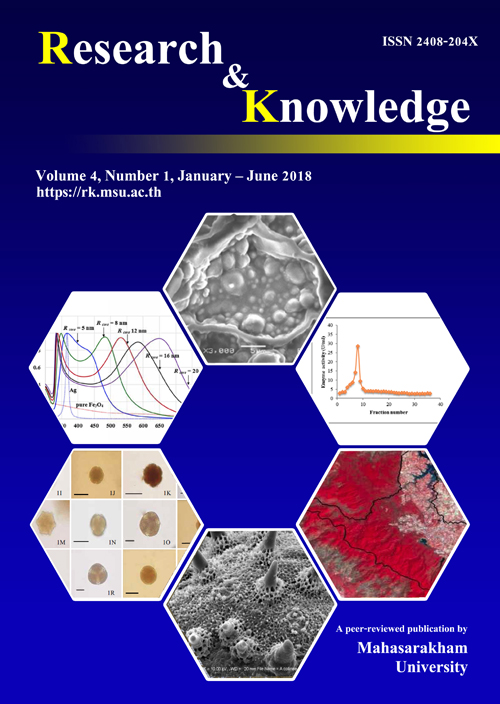Above ground carbon biomass assessment using satellite remote sensing reflection values
Keywords:
Above ground carbon biomass, remote sensing, FVC, MSAVI2Abstract
This research focused on the estimation of above ground carbon biomass of orchards in Sang Kho Sub-District, Phu Phan District, Sakon Nakhon Province in the northeast of Thailand using remote sensing with Modified Soil Adjusted Vegetation Index-2 (MSAVI2) and Fractional Vegetation Cover (FVC). The study methodology was conducted by bringing data from Landsat 8 OLI to adjust the reflection of the Top of Atmosphere (ToA) and classify the vegetation by using MSAVI2. Pixel values above 0-1 were determined to be vegetation and pixel values equal to or below 0 were determined not to be vegetation. Then, the pixel value was determined to classify the vegetation to be 0-100 by using FVC and the satellite data obtained from the previous process was applied to determine the correlation with the field data by statistical methods to get the correlation equation y = 0.0874e0.064x with a coefficient of determination R² = 0.9123. The calculation resulted in an above ground carbon content of 277.430 tCO2 /rai. In addition, the researchers also tested the statistical accuracy of the above ground carbon, which could be analyzed by Landsat 8 OLI and field data with a Paired Sample T-test. The result found no statistically significant difference at a confidence level of 95%.
References
Campbell, J. B. 1996. Introduction to Remote Sensing. Taylor & Francis, London.
Jundang, W., Puangchit, L. and Diloksumpun, S. 2010. Carbon storage of dry dipterocarp forest and eucalypt plantation at Mancha Khiri plantation, Khon Kaen Province. Thai Journal of Forestry 29 (3), 36-44.
Klinhom, U., Laosuwan, U., Uttaruk, P., Junggoth, R., Thamsenanupap, P. and Wongpakam, K. 2011. Carbon offset in forest sector. Final report carbon offset in forest sector project. National Research Council of Thailand (NRCT).
Laosuwan, T., Chunpang, P. and Sukkasena, S. 2011. Development of robotic aerial remote sensing system for field educational purpose. International Journal of Geoinformatics 7 (4), 21-27.
Laosuwan, T., Utharak, P. and Ponthum, N. 2012. Carbon credit: Global warming reduction business. Journal of science and technology Mahasarakham University 31(2), 178-185.
Laosuwan, T. and Uttaruk, P. 2014. Estimating tree biomass via remote sensing, MSAVI 2, and fractional cover model. IETE Technical Review 31(5), 362-368.
Laosuwan, T. and Uttaruk, Y. 2016. Estimating above ground carbon capture using remote sensing technology in small scale agroforestry areas. Agriculture and Forestry 62 (2), 253–262.
Laosuwan, T., Sangpradid, S., Gomasathit, T. and Rotjanakusol, T. 2016. Application of remote sensing technology for drought monitoring in Mahasarakham Province, Thailand. International Journal of Geoinformatics 12 (3), 17-25.
Laosuwan, T., Gomasathit, T. and Rotjanakusol, T. 2017. Application of remote sensing for temperature monitoring: The Technique for Land Surface Temperature Analysis. Journal of Ecological Engineering 18 (3), 53-60.
Liaghat, S. and Balasundram, S. K. 2010. A review: The role of remote sensing in precision agriculture. American Journal of Agricultural and Biological Sciences 5, 50-55.
Litynski, J. T., Klara, S.M. McIlvried, H. G. and Srivastava, R. D. 2006. The United States Department of Energy’s regional carbon sequestration partnerships program: A collaborative approach to carbon management. Environment Internationa 32, 128-144.
Lu, D., Mausel, P., Brondizio, E. and Moran, E. 2002. Assessment of atmospheric correction methods for Landsat TM data applicable to Amazon basin LBA research. International Journal of Remote Sensing 23, 2651-2671.
Odindi, J. O., Bangamwabo, V. and Mutanga, O. 2015. Assessing the value of urban green spaces in mitigating multi-seasonal urban heat using MODIS Land Surface Temperature (LST) and Landsat 8 data. International Journal of Environmental Research 9(1), 9-18.
Ogawa, H., Yoda, K., Ogini, K. and Kira, T. 1965. Comparative ecological study on three main type of forest vegetation in Thailand. Nature and Life in Southeast Asia 4, 49-80.
Senpaseuth, P., Navanugraha, C. and Pattanakiat, S. 2009. The estimation of carbon storage in dry evergreen and dry dipterocarp forests in Sang Khom District, Nong Khai Province, Thailand Environment and Natural Resources Journal 7(2), 1-11.
Vicharnakorn, P., Shrestha, R. P., Nagai, M., Salam, A. P. and Kiratiprayoon, S. 2014. Carbon stock assessment using remote sensing and forest inventory data in Savannakhet, Lao PDR. Remote Sensing 6, 5452- 5479.
Uttaruk., Y. and Laosuwan, T. 2016. Remote sensing based vegetation indices for estimating above ground carbon sequestration in orchards Agriculture and Forestry 62 (4), 193-201.
Uttaruk., Y. and Laosuwan, T. 2017. Carbon sequestration assessment of the orchards using satellite data. Journal of Ecological Engineering 18 (1), 11-17.
Downloads
Published
How to Cite
Issue
Section
License

This work is licensed under a Creative Commons Attribution-NoDerivatives 4.0 International License.







